Breeding
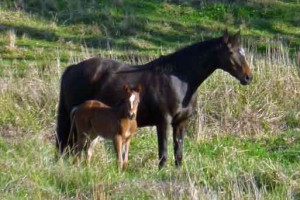
Haydon Tourmaline, a full sister to Haydon Angel Jewel, has been a remarkable broodmare. Her first filly played in the Argentine Open and she has produced another six good daughters to date and the sire Haydon Oracle in the UK. This is her 2011 filly Haydon Crystalline.
The stud’s aim is to produce horses that can ultimately perform at the elite levels.
A lot of the Haydon Horse Stud’s success stems from it’s mares which trace mother to daughter right back to when the Haydon’s first settled Bloomfield back in 1832 and started breeding horses. By breeding from the best of each generation to superior stallions will greatly enhance the horses. You must be able to give every horse in the pedigree a big tick. Once you have a pedigree with crosses you are going backwards. The Stud has always been very hard on eliminating bloodlines that do not suit.
The depth of the families has produced very strong female lines because the policy of only breeding from the best females in each family, has been strictly adhered to.
There has always been an unyielding belief in the old adage, “the mare is 80% of breeding”.
A recent study of over 400,000 mares on the American Jockey Club database supported this adage showing “foals from Grade 1 winning mares earn more than 2.3 times the average and are 5 times more likely to win a graded stakes than the average.” A similar Australian study found that mares granted championship status produced 6 times more stake winners then the breed average.
The top class female runners make the best producers.
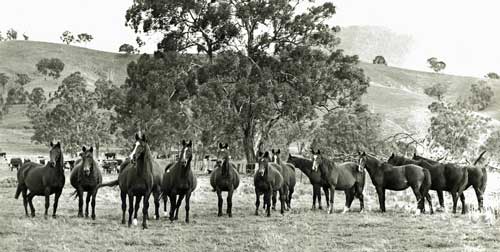
A group of the Studs broodmares in the 1980’s
Selection Criteria
Haydon Horse Stud has established a strict breeding regime with their horses. Emphasis is placed on temperament, lightness, mouths, conformation and action. In a nutshell we look for a horse with a good correct flat head, a sloping shoulder and an outstanding forward stifle.
There is not room here to list all the attributes we look for but the main things are listed below.
- A good head with a flat forehead, a big, kind, soft eye is selected for to achieve the required temperament
- Correct conformation with scope
- Lightness on the lead and a responsive light mouth
- The placement of the hind leg with a strong, forward stifle is essential as it dictates the ability of the horse
- A correct, light, smooth, comfortable and neat action completes the picture.
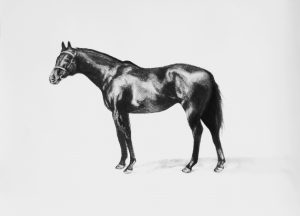
Haydon Drawn
It is a very fine line breeding a horse that is trainable, co-operative and who wants to be with you but at the same time has the character or that special “X Factor” to perform at the highest level. Emphasis is continually put into achieving the right balance between the horse that is just too docile to one that has too much energy, which takes years longer to train and even then may not make it. The “Champion Horse” has special characteristics and the genetics from these champion horses are widely incorporated in our breeding program.
With such selective breeding we are now finding young horses with natural ability coming through that have the feel they have “been there before” or “were born fully trained”. Two years in the first month of training will follow the ball around using “no reins” as it is so bred into them. The stud’s horses are renowned for putting the ball just in the right spot no matter the situation and not too close or too far away. It is important that these horses are still given the time to mature and to resist the temptation to use them ahead of their time.
Importantly, the actual time you have to spend training horses with this type temperament is greatly reduced and long gone are the days when horses required years of hard stock work or time on the road droving.
Joining and Foaling
Stallions are paddock mated with our mares from 1 September to 31 December each year. They are kept in good condition and it is unusual if a mare does not have a foal every year. The mares are foaled out unassisted as they have been for generations. Any foals with legs which are not straight are not retained. Entries in the older books simple read “crooked leg-deceased”.
In more recent years embryo transfer has been used and frozen semen is available from the stud’s stallions.
Training
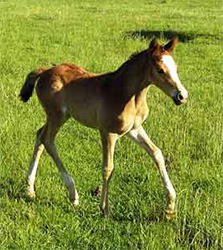 Foals
Foals
Foal are born naturally in the paddock and roam freely with their mother in big paddocks in the hill country at Scott’s Creek. All foals are handled on their mothers to learn to lead and to tie up. We tie up with a lead from the neck strap going around a post and back onto the front leg. This means as they pull back their front leg comes forward, teaching themselves to tie up with no stress on their neck.
Weaning Time
Foals are all handled again on their mothers to a stage where they can be loaded onto the gooseneck trailer and brought down to Bloomfield. They are individually stabled for a week, led out each day, tied up and hosed down. During this time they are vaccinated, drenched, freeze branded and have their feet and manes done. They are then turned out in paddocks and fed each day. The aim is to have them coming up to eat out of a bucket and to be caught in the paddock. It is a good time to come and buy with a good selection and with minimal value adding.
Two Year Olds
In November each year the two olds start their ridden training. In the past we always started our young horses ourselves but by out-sourcing them now we can concentrate more on the next stages of training.
After a month the horses are up to stick and ball stage, going around nicely and hitting a ball on them. They are given some gentle stock work and started very slowly in young horse chukkas.

Horses at Young Horse Chukkas
Three Year Olds
The two and a half and three olds come back into work in February and are played in the slow subsidiary chukkas at Scone.
Later in the year they get stock work before going back to 10 days of young horse chukkas. By this stage they will be flowing along relaxed ready to take the next step.
Four Year and Older
The four year olds gradually progress through the system playing the League at Scone and low goal chukkas. More competitive chukkas are played as they mature making sure they are ready to accept the pressure of the next stage.
Horses are sold at all ages depending on the need of the client. We guarantee our product and replacements are found if the new horse and owner/ rider combination are not getting on as well as expected.
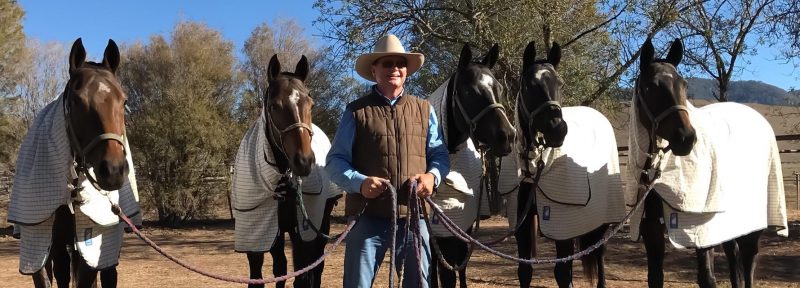
Peter Haydon 2018 winners of the Peisley Cup at Scone
